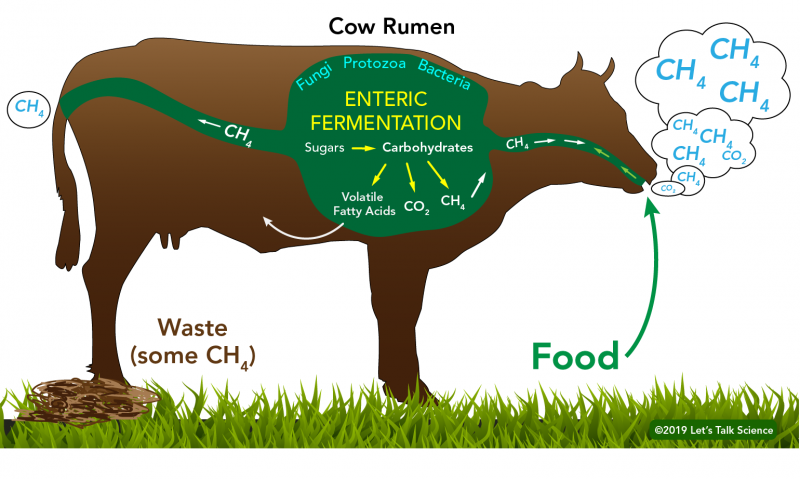Livestock Farming Emissions
Livestock animals raised for meat dairy eggs and seafood production contribute to emissions in several ways. Lastly the researchers explored to what extent the methane emissions from the livestock sector will change in the future how much mitigation potential.
For example there are solutions that can only be used as a last resort when the sustainability of livestock farming is called into question by stricter regulations.

Livestock farming emissions. However the truth is that agriculture as a whole constitutes about 135 of all world greenhouse gas emissions. Management of agricultural soils accounts for just over half of the greenhouse gas emissions from the Agriculture economic sector Livestock especially ruminants such as cattle produce methane CH 4 as part of their normal digestive processes. This makes Australias livestock the third largest source of greenhouse gas emissions after the energy and transport sectors.
Cows pigs and other farm livestock in Europe are producing more greenhouse gases every year than all of the blocs cars and vans put together when. For livestock production systems nitrous oxide methane and carbon dioxide emissions are losses of nitrogen energy and organic matter that undermine efficiency and productivity. Independent beef and sheep specialist Dr Liz Genever has worked with both farms to help slash emissions.
The way in which manure from livestock is managed also contributes to CH 4 and N 2 O emissions. Investing in treatment units to reduce nitrogen emissions is an unproductive economic investment for livestock farming an energy aberration and a disastrous material balance. Livestock on farms produce a lot of manure and thus a lot of ammonia which is harmful for the environment and reduces biodiversity.
With little to no climate action in the agriculture sector greenhouse gas emissions from. The remaining 30 are emissions from manure and manure storage. Livestock supply chains emitted an estimated total of 81 gigatonnes CO 2-eq in 2010 using 298 and 34 as global warming potential for N 2 O and CH 4 respectively.
The methane is released primarily through belching. The agricultural sector is responsible for 10 of total greenhouse gas emissions in Flanders. Livestock fisheries account for 31 of food emissions.
Building on more than a decade of analysis of ghg abatement we have identified the top 25 measures to reduce on farm emissions and organized them into a marginal abatement cost curve macc. Of that 10 about half is methane 49. Central government is taking steps to cut ammonia emissions.
Livestock farming emissions. Ruminant livestock mainly cattle for example produce methane through their digestive processes in a. Agriculture Forestry and Other Land Use 104 2019 Refinement to the 2006 IPCC Guidelines for National Greenhouse Gas Inventories 10B1 Raw data used to compile Annex A1 enteric fermentation Tier 1 emission factors.
This process is called enteric fermentation and it represents over a quarter of the emissions from the Agriculture economic sector. Greenhouse gases and agriculture. Most of those methane emissions come from enteric fermentation 70.
Livestocks Greenhouse Gas Emissions It is often claimed that animal agriculture is to blame for 51 of greenhouse gas emissions and releases more than the entire transportation sector. Livestock are the dominant source of methane CH 4 and nitrous oxide N 2 O accounting for 56 and 73 respectively of Australias emissions. The next largest portion of livestock greenhouse gas emissions is from methane produced during enteric fermentation in ruminants a natural part of ruminant digestion where microbes in the first of four stomachs the rumen break down feed and produce methane as a by-product.
What is the impact of livestock farming. Bryn Farms carbon emission balance is -8287 tonnes CO2e whilst for Hendre Ifan Goch it is -19701 tonnes CO2e and both have high levels of soil organic matter. The livestock sector is a significant contributor to global human-induced GHG emissions.
Possible interventions to reduce emissions are therefore to a large extent based on technologies and practices that improve production efficiency at animal and herd levels. Ammonia emissions from farms.
Climate Change Pollution How Much Is Due To Meat Dairy Climates Vegan Memes Climate Change
Greenhouse Gas Emissions From Livestock Farming In The European Union Account For 17 Of Total Eu Emissions And Cause More Livestock Farming Climates Livestock
Pin On Environmental Impact Of Meat And Dairy Production
Pin On Articles Methane Mitigation Oxidation
What A Lot Of Bull Greenhouse Gas Emissions Greenhouse Gases Emissions
Pin On Top Facts Good Quotes Memes On Veganism Vegetarianism



Post a Comment for "Livestock Farming Emissions"